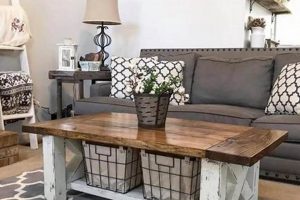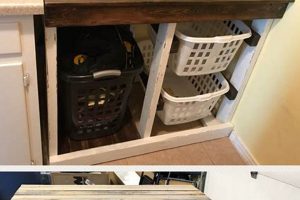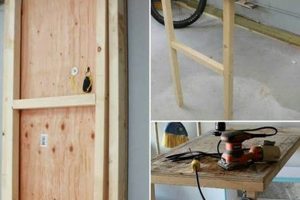A self-constructed miniature version of a popular arcade game, involving a smooth, low-friction surface over which players attempt to score using handheld strikers and a puck. Typically, these units employ a fan to generate an air cushion, further reducing friction. An example is a tabletop game crafted from plywood, PVC piping, and a repurposed blower fan.
The construction of these devices provides a cost-effective alternative to commercially manufactured air hockey tables, offering recreational enjoyment while fostering creativity and problem-solving skills. Furthermore, the practice allows for customization in size and design, adapting the game to available space and personal preferences. Historically, similar endeavors involving the creation of games and recreational equipment from readily available materials have been observed across various cultures and socioeconomic backgrounds.
The following sections will explore the materials, tools, and construction techniques commonly employed in building a unit, along with considerations for power supply, surface finish, and structural integrity. Specific attention will be given to alternative designs and troubleshooting common issues encountered during the building process.
Construction Guidance
The following guidance offers practical advice for successful fabrication. Adherence to these points can significantly improve the functionality and longevity of the finished product.
Tip 1: Surface Material Selection: Opt for a smooth, non-porous material such as melamine-coated particleboard or acrylic sheeting. These materials provide a low-friction surface essential for optimal puck movement. Avoid porous materials like untreated wood, as they can absorb moisture and increase friction.
Tip 2: Airflow Optimization: Evenly distribute air across the playing surface. Use a fan with sufficient CFM (cubic feet per minute) for the table size. Strategically placed air holes, approximately 1/16 to 1/8 inch in diameter and spaced 1-2 inches apart, promote uniform airflow.
Tip 3: Structural Reinforcement: Ensure a rigid frame construction. Use wood screws and wood glue to assemble the frame, providing stability and preventing warping. Consider adding cross-braces for larger tables to maintain a level playing surface.
Tip 4: Puck and Striker Design: Design strikers that are appropriately sized and weighted for the table. Use materials like ABS plastic or machined wood for durability. Select a puck with a smooth, even surface to minimize friction and ensure predictable movement.
Tip 5: Electrical Safety: When integrating a fan, ensure proper wiring and insulation. Use a grounded power cord and consider installing a fuse for electrical safety. Enclose the fan unit to prevent accidental contact with moving parts.
Tip 6: Leveling: Implement adjustable feet or shims to ensure the table is perfectly level. An uneven surface significantly impacts gameplay. Use a bubble level to verify the table’s levelness before each use.
Tip 7: Edge Construction: Construct sturdy edges or rails around the perimeter. These prevent the puck from flying off the table and define the playing area. Securely attach the edges with screws and glue for long-term durability.
Effective implementation of these recommendations allows for the creation of a functional and engaging recreation device. These modifications improve performance and ensure a durable construction.
The subsequent section will outline alternative designs and variations, offering further customization options.
1. Surface Friction
Surface friction is a critical factor in the performance of a self-constructed air hockey table. The degree of friction between the puck and the playing surface directly impacts puck speed, trajectory, and overall gameplay quality. Selection of appropriate materials and surface treatments is therefore paramount in creating a functional and enjoyable recreational device.
- Material Selection and Friction Coefficient
The choice of material for the playing surface directly dictates its friction coefficient. Materials such as melamine, acrylic, and high-density polyethylene (HDPE) exhibit lower friction coefficients compared to raw wood or rough plastics. Lower friction translates to faster puck movement and a more authentic air hockey experience. Using unsuitable materials necessitates a stronger airflow system to compensate for increased resistance.
- Surface Finish and Texture
Even with suitable materials, the surface finish significantly affects friction. Polished or smooth surfaces reduce contact points between the puck and the playing surface, minimizing friction. Conversely, textured or uneven surfaces increase contact area, leading to greater friction. Applying a sealant or polish can further reduce friction and improve puck glide.
- Airflow and Boundary Layer Effect
The airflow system interacts with the playing surface to create a thin layer of air that supports the puck, effectively reducing friction. Insufficient airflow diminishes this effect, increasing friction and slowing the puck. Even distribution of air is crucial; localized variations in airflow can create uneven friction, affecting puck trajectory and predictability. The balance between airflow strength and hole density directly influences the effectiveness of friction reduction.
- Puck Material and Cleanliness
The puck’s material composition and surface condition also contribute to the overall friction. Pucks made from smooth, hard plastics, such as polycarbonate or ABS, typically exhibit lower friction than those made from softer materials. Regular cleaning of the playing surface and puck is essential to remove dust and debris that can increase friction and impede puck movement. Abrasive cleaning agents should be avoided to prevent surface damage.
Ultimately, optimizing surface friction in a self-built air hockey table requires careful consideration of material selection, surface finish, airflow system design, and puck characteristics. Achieving a balance between these elements results in a playing surface that facilitates fast, smooth puck movement, enhancing the overall quality and enjoyment of the game. Failure to address surface friction adequately can lead to a suboptimal playing experience characterized by sluggish puck movement and inconsistent gameplay.
2. Airflow Consistency
Airflow consistency represents a critical parameter in the functionality of a self-constructed air hockey table. The even distribution of air across the playing surface directly impacts puck movement, gameplay dynamics, and overall user experience. Deviations from consistent airflow can lead to unpredictable puck behavior and diminished enjoyment.
- Hole Distribution and Density
The pattern and density of air holes drilled into the playing surface directly influence airflow uniformity. Irregular spacing or inconsistent hole sizes can create localized areas of high or low pressure, resulting in uneven puck levitation. Careful planning and precise execution are required to ensure a consistent distribution of air holes across the entire playing surface. The optimal hole density is dependent on fan strength and table size, requiring empirical testing for determination. Examples include creating templates to maintain consistent spacing or utilizing a drill press for uniform hole depth and diameter.
- Fan Selection and Placement
The selection of an appropriate fan with sufficient CFM (cubic feet per minute) is essential for achieving adequate airflow. Undersized fans fail to provide sufficient air pressure to levitate the puck effectively. Placement of the fan within the table’s plenum also impacts airflow distribution. Centralized fan placement may result in higher pressure in the center of the table compared to the edges, necessitating the use of baffles or diffusers to redirect airflow. Examples include utilizing computer fans for smaller tables or blower fans for larger designs. Proper sealing around the fan enclosure is also essential to prevent air leakage and maintain pressure.
- Plenum Design and Airflow Impedance
The plenum, or air chamber beneath the playing surface, plays a crucial role in distributing air evenly. Inadequate plenum volume or internal obstructions can impede airflow and create pressure differentials across the table. The plenum should be designed to minimize turbulence and promote uniform airflow distribution. Examples include incorporating angled walls or rounded corners to reduce airflow resistance. Consideration must also be given to the materials used in the plenum construction, as porous materials can absorb air and diminish overall airflow efficiency.
- Sealing and Air Leakage Prevention
Air leaks along the edges of the playing surface or within the plenum can significantly reduce airflow consistency. Even small leaks can diminish air pressure in certain areas, leading to uneven puck levitation. Thorough sealing of all joints and seams is essential to maintain consistent airflow across the entire table surface. Examples include using silicone caulk or weather stripping to seal gaps. Regular inspection and maintenance are also necessary to identify and repair any developing air leaks.
In summation, the attainment of airflow consistency in a self-made air hockey table demands meticulous attention to hole distribution, fan selection and placement, plenum design, and air leakage prevention. The interplay of these elements directly affects puck dynamics and the overall quality of the game. Addressing these considerations methodically will enable the creation of a functional and enjoyable recreational device.
3. Structural Integrity
Structural integrity is a foundational requirement for a self-constructed air hockey table. It dictates the longevity, stability, and safe operation of the game, ensuring consistent performance and preventing premature failure. Compromised structural integrity can lead to warping, instability, and eventual collapse, rendering the table unusable.
- Frame Construction and Material Selection
The frame serves as the primary load-bearing element of the air hockey table. Material selection significantly impacts the frame’s ability to withstand stress and maintain its shape. Wood, particularly plywood or solid hardwoods, is a common choice due to its strength-to-weight ratio and ease of workability. However, improper joint construction or the use of low-quality materials can compromise the frame’s integrity. Reinforced joints, such as those utilizing screws, glue, and corner braces, are crucial for distributing stress and preventing joint failure. An example is the use of mortise and tenon joints in hardwood frames for increased strength compared to simple butt joints.
- Surface Support and Reinforcement
The playing surface must be adequately supported to prevent sagging or deflection under load. The spacing and strength of the underlying support structure directly impact the surface’s ability to maintain a level playing field. Insufficient support can lead to uneven puck movement and inconsistent gameplay. Reinforcement methods, such as adding cross-braces or a solid backing panel, enhance the surface’s rigidity and prevent warping. An example is the use of a grid of wooden ribs beneath a thin playing surface to distribute weight evenly.
- Leg Stability and Weight Distribution
The legs must provide a stable and level platform for the air hockey table. The design and attachment method of the legs influence the table’s ability to resist tipping or wobbling. Wide-stance legs and secure attachment points are essential for distributing weight evenly and preventing instability. Adjustable feet can compensate for uneven floor surfaces and ensure a level playing field. An example is the use of splayed legs with rubber feet to increase stability and prevent slippage on smooth surfaces.
- Joint Strength and Fastener Selection
The integrity of the joints connecting the various components of the air hockey table is critical for overall stability. Weak or poorly constructed joints can lead to structural failure under stress. The selection of appropriate fasteners, such as screws, bolts, or nails, is essential for creating strong and durable joints. Glue, when used in conjunction with mechanical fasteners, can further enhance joint strength and prevent movement. An example is the use of countersunk screws and wood glue to create flush and secure joints between the frame members.
The preceding facets highlight the interdependency of frame construction, surface support, leg stability, and joint strength in ensuring the structural integrity of a self-made air hockey table. Employing robust materials, sound construction techniques, and careful attention to detail are crucial for creating a durable and enjoyable recreational device. Inadequate structural design will result in a product with limited lifespan and a compromised playing experience.
4. Puck Dynamics
Puck dynamics, encompassing the puck’s mass, material composition, and surface characteristics, directly influences the gameplay of a self-constructed air hockey table. The selection of an appropriate puck dictates speed, friction, and responsiveness, thereby determining the overall user experience. An improperly chosen puck can render the table difficult or unenjoyable to play, negating the benefits of a well-constructed frame and airflow system. For instance, a puck with excessive mass requires greater airflow to achieve adequate levitation, potentially overloading the fan and diminishing its lifespan. Conversely, a puck with insufficient mass may exhibit excessive speed and reduced control, making the game challenging even for experienced players.
The relationship between puck dynamics and the air hockey table extends to the materials used in puck construction. Pucks constructed from high-density polyethylene (HDPE) or polycarbonate offer a balance between durability, smoothness, and weight. The smoothness is important in maintaining lower friction and optimal speed. Uneven surfaces can increase friction, reduce speed, and create inconsistent trajectories. As an example, it is commonly seen that using damaged pucks can cause game malfunctions, especially the trajectory can become inconsistent.
In conclusion, the interplay between puck dynamics and air hockey table design constitutes a fundamental element in achieving a functional and enjoyable self-made game. By carefully considering the puck’s mass, material composition, and surface characteristics, builders can optimize gameplay, prevent equipment malfunctions, and create an experience that mirrors the performance of commercially manufactured tables. Failure to account for these dynamics can lead to a suboptimal playing experience and diminish the overall value of the project.
5. Power Safety
Electrical power is a critical component of an air hockey table’s functionality, driving the fan system responsible for puck levitation. However, the integration of electrical components into a self-constructed project presents inherent safety risks. Mitigation of these risks requires careful planning, adherence to electrical safety standards, and proper execution of wiring and insulation techniques. The following points outline crucial considerations for ensuring power safety during the construction and operation of a unit.
- Grounding and Fault Protection
Proper grounding is essential for preventing electrical shock hazards. The electrical system should be grounded according to applicable electrical codes. In the event of a fault, a grounding conductor provides a low-resistance path for current to flow back to the source, tripping a circuit breaker or fuse. A ground fault circuit interrupter (GFCI) provides additional protection by detecting small imbalances in current flow and quickly disconnecting power. An example would be ensuring that the metal chassis of the fan is properly grounded to the electrical outlet’s ground pin. Failure to ground electrical components can result in serious injury or death in the event of an electrical fault.
- Wiring and Insulation
Proper wiring techniques and adequate insulation are critical for preventing short circuits and electrical fires. Wires should be appropriately sized for the current they will carry, and connections should be secure and well-insulated. Exposed wiring presents a significant shock hazard and should be avoided. Strain relief measures should be implemented to prevent wires from being pulled or damaged. An example includes using properly rated wire connectors and securing wires with cable ties to prevent chafing. Damaged or frayed insulation can create a fire hazard and increase the risk of electrical shock.
- Fuse Protection and Circuit Breakers
Fuses and circuit breakers provide overcurrent protection, preventing damage to electrical components and reducing the risk of fire. A fuse contains a thin wire that melts and breaks the circuit when the current exceeds a specified level. A circuit breaker is a resettable device that automatically trips when an overcurrent condition is detected. Both devices should be rated appropriately for the circuit they are protecting. An example is the use of a 5-amp fuse in a circuit powering a small fan motor. Failure to install overcurrent protection can result in overheating, equipment damage, and fire.
- Enclosure and Physical Protection
Electrical components should be housed within a suitable enclosure to protect them from physical damage and prevent accidental contact. The enclosure should be made from non-conductive materials and should be adequately ventilated to prevent overheating. Access to electrical components should be restricted to prevent tampering or unauthorized access. An example is housing the fan motor and wiring within a plastic enclosure with a secure cover. Failure to provide adequate physical protection can result in damage to electrical components, electrical shock, and fire.
These enumerated safety measures, when carefully implemented, can significantly reduce the risks associated with integrating electrical power into a self-made air hockey table. A thorough understanding of electrical safety principles, combined with meticulous execution, is paramount for ensuring the safe and reliable operation of the device. Neglecting these considerations can have serious consequences, underscoring the importance of prioritizing safety throughout the construction process.
Frequently Asked Questions
The subsequent section addresses common inquiries regarding the construction of a self-made air hockey table. Clarity on these issues facilitates project planning and execution.
Question 1: What is the optimal material for the playing surface?
A smooth, non-porous material such as melamine-laminated particleboard or acrylic sheeting is recommended. These materials exhibit low friction coefficients, promoting optimal puck movement. Avoid porous materials like untreated wood, which increase friction and impede gameplay.
Question 2: How is adequate airflow achieved?
Employ a fan with sufficient CFM (cubic feet per minute) for the table size. Distribute air evenly across the playing surface by drilling appropriately sized air holes (approximately 1/16 to 1/8 inch in diameter) spaced 1-2 inches apart. Experimentation may be required to determine the optimal hole density and fan speed.
Question 3: What steps ensure structural stability?
Construct a rigid frame using wood screws and wood glue. For larger tables, consider adding cross-braces to maintain a level playing surface and prevent warping. Ensure legs are securely attached and capable of supporting the table’s weight.
Question 4: How is electrical safety addressed?
Ground all electrical components according to applicable electrical codes. Use appropriately sized wiring and secure all connections. Install a fuse or circuit breaker to provide overcurrent protection. Enclose the fan unit to prevent accidental contact with moving parts.
Question 5: How can surface friction be minimized?
In addition to selecting a low-friction material, polish the playing surface to further reduce friction. Regularly clean the surface to remove dust and debris. Select a puck made from a smooth, hard plastic.
Question 6: What are common troubleshooting issues?
Uneven puck movement may indicate uneven airflow or a warped playing surface. Slow puck speed may result from insufficient airflow, high friction, or an over-weighted puck. Instability may be due to a weak frame or poorly attached legs. Electrical issues should be addressed immediately by a qualified individual.
Understanding these core concepts allows for a more informed and successful construction endeavor. The provided guidance should assist in mitigating common challenges.
The concluding section presents a summary of key considerations and future directions for enhancement.
DIY Air Hockey Table
The preceding analysis has detailed critical facets of constructing a functional diy air hockey table. Key elements discussed encompass material selection, airflow dynamics, structural integrity, puck properties, and electrical safeguards. Careful consideration of each aspect is essential for a durable and enjoyable recreational device. Failure to address these factors adequately can result in diminished performance, compromised safety, and reduced lifespan of the self-built apparatus.
Further refinement of construction techniques and exploration of alternative materials may yield enhanced performance characteristics and improved user experiences. Continued adherence to established safety protocols and rigorous testing are paramount for ensuring responsible and reliable operation of homemade recreational equipment. The ongoing pursuit of innovation and a commitment to responsible construction practices will define the future evolution of the diy air hockey table.







